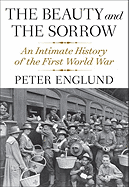
Instead of yet another book discussing what happened in the First World War and why, Swedish historian and war correspondent Peter Englund has written "about what it was like." The Beauty and the Sorrow follows 20 individuals through the course of the war: male and female, combatants and non-combatants, none of them "important" in the traditional historical sense, and most of them far from the well-known mud and trenches of the western front. The youngest is a 12-year-old German schoolgirl; the oldest a fragile 50-something Scotswoman who goes to the front as an aide worker. The most unlikely are a Canadian opera singer married to a Polish count and a Venezuelan adventurer who joins the Ottoman army after several of the Allied powers reject him.
Englund casts his narrative in the present tense, giving it unusual immediacy, and relies heavily on the letters and journals of his subjects. They are all remarkably articulate and thoughtful, even the 12-year-old. Much of what he presents lies outside the scope of other works on the war, and even familiar facts are presented with new twists.
Fast-paced and thought-provoking, The Beauty and the Sorrow is a truly extraordinary history of the First World War that deserves a place beside such classics as Barbara Tuchman's The Guns of August, Paul Fussell's The Great War and Modern Memory and Robert Graves's Good-bye to All That. --Pamela Toler, blogging at History in the Margins

